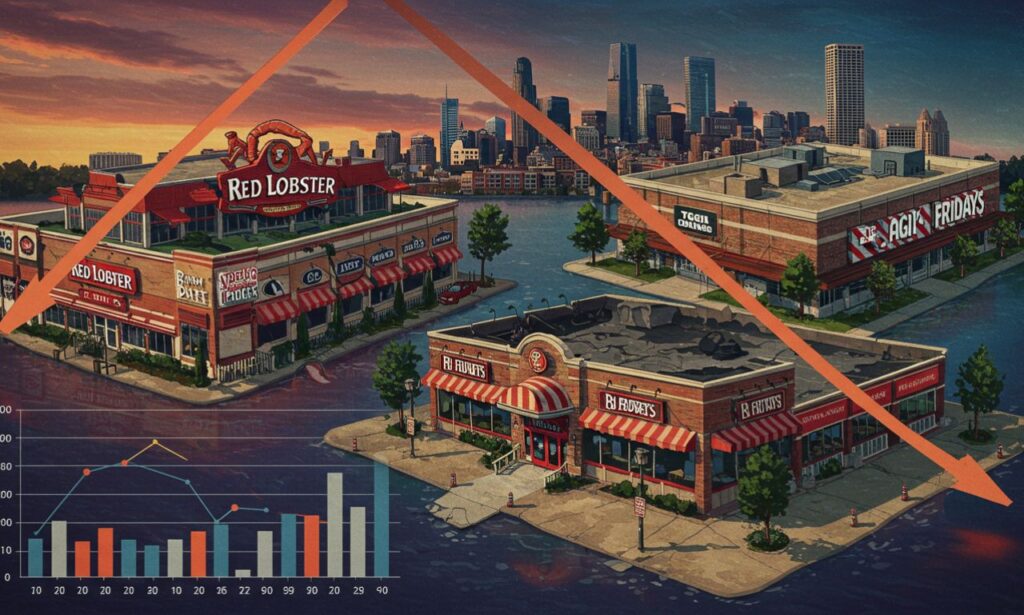In recent months, news of Red Lobster TGI Fridays closing multiple locations has made waves in the restaurant industry. These two household names, known for affordable comfort food and relaxed atmospheres, are facing a mix of economic and cultural challenges. The closures are not just about shuttered storefronts—they reflect broader shifts in how Americans eat, spend, and socialize.
Red Lobster TGI Fridays Closing Locations in 2025
Both Red Lobster and TGI Fridays have confirmed store closures in various states. While the exact number fluctuates as negotiations and lease agreements change, several outlets in urban and suburban areas have already closed their doors.
Red Lobster has been particularly affected in high-rent markets, where operating costs have risen faster than revenue. TGI Fridays, meanwhile, has concentrated its closures in regions where foot traffic has dropped significantly since the pandemic.
For communities, these closures can mean job losses and the disappearance of familiar neighborhood spots. For the companies, they represent tough decisions aimed at long-term survival.
Why Are Red Lobster and TGI Fridays Closing Locations?
Rising Operational Costs
The cost of running a restaurant has skyrocketed in the past three years. From increased wages to soaring food prices, both chains have faced shrinking profit margins.
Shifting Consumer Preferences
Casual dining chains once thrived on family gatherings and after-work hangouts. Today, more diners prefer quick-service restaurants, delivery apps, and specialty local eateries. The convenience and variety offered by these alternatives have eaten into traditional sit-down dining.
Pandemic Aftershocks
Even though dining restrictions have lifted, the pandemic altered habits. Remote work has reduced weekday lunch crowds, while inflation has made eating out less frequent for many families.
Real Estate Pressures
Red Lobster’s large-format stores require significant square footage, often in premium locations. As rents climb, underperforming locations are harder to justify. TGI Fridays, with smaller but still dine-in-focused spaces, faces similar challenges.
Industry Trends Driving Closures
The Red Lobster TGI Fridays closing story is part of a larger trend in casual dining. Many once-dominant chains are downsizing, rebranding, or shifting to smaller footprints. Some are introducing fast-casual hybrids, offering quicker service without losing brand identity.
Additionally, loyalty programs and targeted marketing have become crucial to retaining customers. Restaurants that fail to integrate technology—from mobile ordering to AI-driven menu optimization—risk falling behind.
How Customers Are Reacting
For loyal patrons, the news has been bittersweet. Social media is filled with nostalgic posts about first dates, family celebrations, and after-work gatherings at these restaurants. At the same time, some consumers acknowledge that their own dining habits have changed, making them part of the shift.
Petitions to keep certain locations open have appeared online, but operational realities often outweigh sentimental value.
Corporate Strategies for Survival
Both chains are adapting in different ways:
-
Menu Innovation: Red Lobster is experimenting with seasonal and limited-time offers, while TGI Fridays is focusing on smaller plates and shareable items.
-
Partnerships: Delivery platform collaborations have become a lifeline, helping both brands reach customers beyond their dining rooms.
-
International Growth: While US closures dominate headlines, both companies are exploring expansion in markets where casual dining is still on the rise.
The Bigger Picture for Casual Dining in the US
The struggles of Red Lobster and TGI Fridays are a cautionary tale for the entire industry. Even established brands with strong name recognition must continually adapt to changing consumer behavior, economic pressures, and competitive landscapes.
We’re also seeing a divide: niche local restaurants and high-end dining experiences are thriving, while mid-range chains face more uncertainty. This suggests that the middle ground—once the sweet spot for chains like Red Lobster and TGI Fridays—has become a more challenging space.
Possible Outcomes for the Brands
While closures sound alarming, they don’t necessarily mean the brands are disappearing. Strategic downsizing can free up resources to invest in stronger markets, improve menus, and upgrade customer experiences.
We may see both brands experimenting with new concepts, such as smaller urban locations, more takeout-friendly menus, or integrated entertainment elements.
How Competitors Are Responding
Other casual dining chains are taking note. Applebee’s, Chili’s, and Olive Garden are all refining their approaches to avoid similar outcomes. Some are diversifying revenue streams with catering services, ghost kitchens, and grocery store product lines.
In this competitive environment, agility and data-driven decisions will determine which brands survive—and which fade away.
Final Thoughts
The Red Lobster TGI Fridays closing wave is a sign of the times. Economic realities, shifting consumer preferences, and the long tail of pandemic-era changes have reshaped the casual dining landscape. While closures are never easy for employees or communities, they may be necessary steps for these iconic brands to stay relevant in the years ahead.






